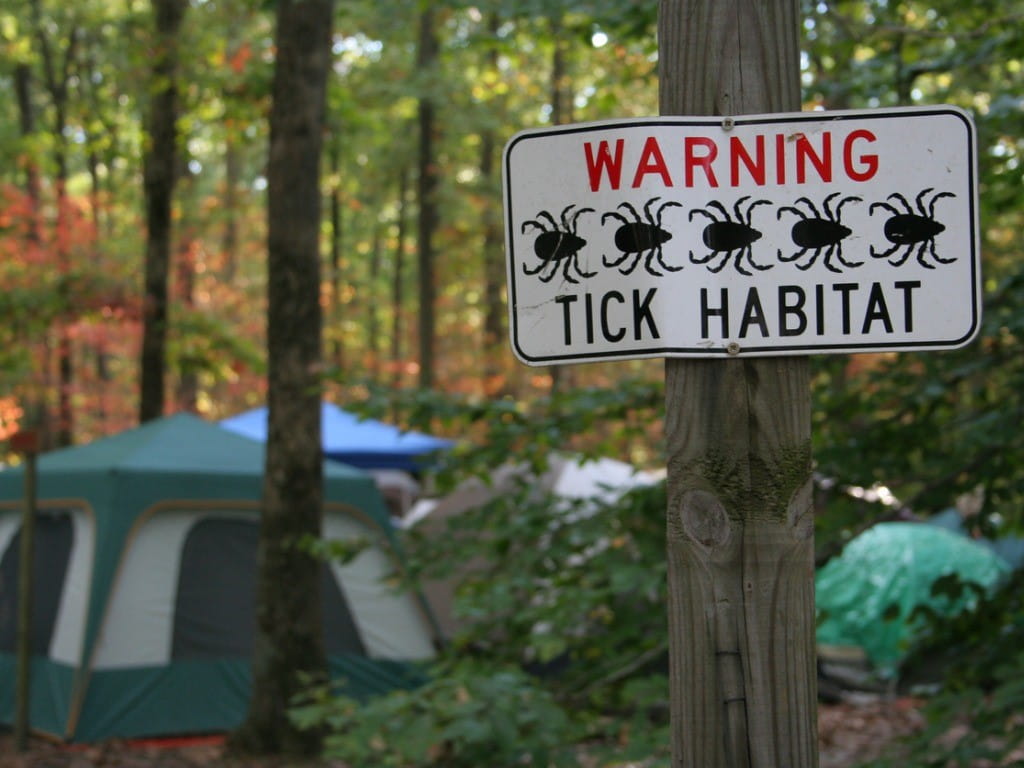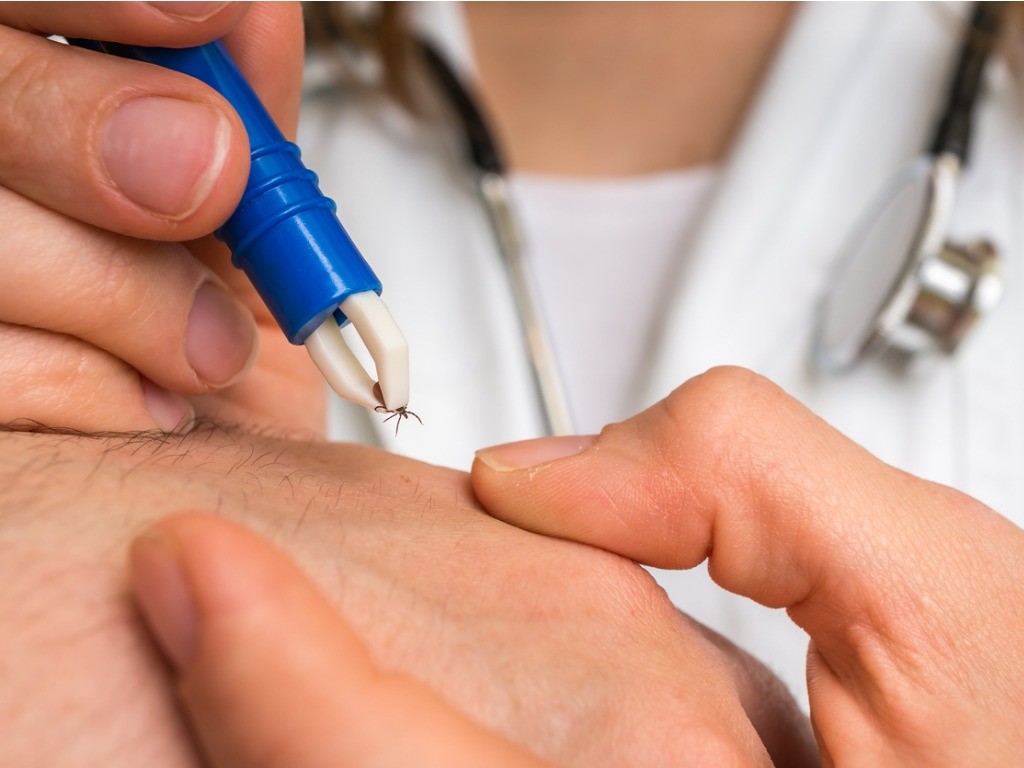Treating Tick Bites

The Bottom Line
Ticks are most active during warmer months (April-September), but tick bites can happen during any time of the year. Ticks live in grassy, wooded, brush-filled areas or even on animals. Tick exposure can happen in your own backyard. See a healthcare provider if you experience fever, rash, or aches within a few weeks of a tick bite.

The Full Story
Ticks are parasites that feed on the blood of animals (including humans), which are then called hosts. Ticks do this by inserting a feeding tube, which is sometimes barbed, into the host and releasing a cement-like substance that anchors them in place. While feeding, ticks leak saliva that has numbing properties and prevents the host from noticing the bite. The feeding can last for days and, if the host has a bloodborne infection, a tick will ingest that as well. When a tick feeds on another host, the bacteria or viruses they previously ingested are transmitted to the new host.
There are many types of diseases that ticks can carry, including Lyme disease and Rocky Mountain spotted fever. The types of ticks and the diseases they commonly carry vary from region to region. To see what ticks and diseases are in your area, check the CDC's Geographic Distribution of Ticks That Bite Humans. Symptoms of these diseases include fever/chills, aches/pain, or rash. See a healthcare provider if any of these symptoms develop within a few weeks after a tick bite.
Diseases from ticks that are caused by bacteria can be treated with antibiotics. Blood tests to confirm an infection are not always available or useful, so treatment depends more on symptoms. Usually, symptoms of a tick-borne bacterial disease occurring days to weeks after a tick bite is reason enough to begin treatment. If a person has experienced a tick bite and has no symptoms, antibiotics are not recommended since the use of unneeded antibiotics can lead to antibiotic resistance. Tick-borne diseases caused by viruses cannot be treated with antibiotics, and specific antiviral treatments are not available. Patients with these viral infections are usually treated by managing symptoms until the infection clears.
Tick paralysis, which is rare, is thought to be caused by a toxin in tick saliva. Patients suffering from tick paralysis experience muscle weakness or inability to move. These symptoms start in the lower limbs and spread up the body. After the tick has been removed, patients with tick paralysis usually start to improve within 24 hours and complete recovery usually occurs within 3 days.
The longer a tick is attached, the more likely diseases or problems will occur because it gives the tick more time to secrete saliva, toxins, and pathogens into the host. Treatment for any tick exposure begins with removing the ENTIRE tick.
- Use fine-tipped tweezers to grip the tick as close the skin as possible.
- Pull upward with steady, even pressure; twisting or jerking can cause the mouth of the tick to break off. If any parts of the tick are stuck in the skin and cannot be removed, see a healthcare provider right away.
- After all of the tick is removed, clean the bite site, the hands of the person that removed the tick, and the tweezers with rubbing alcohol or soap and water.
- Dispose of the tick by putting it in alcohol, placing it in a sealed container/bag, wrapping it in tape, or flushing it down the toilet. (Do not crush the tick with your fingers.)
- Avoid home remedies like coating the tick with nail polish or petroleum jelly or using heat to detach it.
- See a healthcare provider if you are not comfortable removing the tick.
Ticks live in grassy, wooded, brush-filled areas as well as on animals. You can create a safe yard that is not tick-friendly by keeping grass mowed, clearing leaves and debris, and moving playsets and patio furniture away from wooded areas. If you plan to visit a place that might be home to ticks you should wear light colored clothing to make tick spotting easier, wear long pants tucked into boots or socks and long-sleeved shirts to prevent ticks from getting to your skin, and wear shoes that completely cover your feet. Wearing clothes pretreated with tick repellents can be helpful. Clothes can be purchased pretreated with insect repellents or you can pretreat your clothes yourself at home. Chemical repellents containing permethrin as the active ingredient kill ticks on contact. Permethrin repellents can be applied to clothes and camping or hiking gear. It should be applied in a well ventilated area, preferably outdoors, and clothes should be allowed to completely dry before they are put on. The repellent can remain on clothing even after several washings.
Tick repellents containing DEET as the active ingredient work well against biting insects and ticks. DEET repellents can be applied to the skin. DEET concentrations range from 10% to more than 30%. The American Academy of Pediatrics recommends that DEET-containing products used on children contain no more than 30% DEET. Insect repellents are NOT recommended for children younger than 2 months of age.
It is important to read all the instructions and precautions for repellent products. Never spray repellent directly onto someone's face. Instead, spray a small amount of the product on your hands and then rub it on the person's face, making sure to avoid the eyes and the mouth. Wash your hands after applying the product. Do NOT apply the product on cuts, wounds, or irritated skin. (Find an insect repellent that is right for you and approved by the Environmental Protection Agency.)
When checking yourself or others for ticks, extra care should be taken to ensure that ticks are not attached to the underarms, inside or behind the ears, inside belly buttons, back of the knees, in and around the scalp, between the legs, or around the waist. Showering within 2 hours of visiting a tick-infested area reduces the risk of getting Lyme disease and could help reduce the risk of acquiring other tick-borne diseases. Kill ticks on dry clothing by putting the clothing into a dryer on high heat for 10 minutes. Wet clothes must be dried for a longer time to have the same effect. If clothing needs to be washed first, use hot water because cool water will not kill ticks.
Ticks can be tested by commercial labs to identify what diseases they are carrying, but this is often impractical. Positive results for a disease or bacteria do not mean that the person who was bitten is infected. If patients are experiencing symptoms, they should not put off seeing a doctor while waiting for tick testing results.
If bitten by a tick, use the webPOISONCONTROL® online tool for guidance or call Poison Control at 1-800-222-1222.
Lindsy Liu, PharmD
Certified Specialist in Poison Information
Poisoned?
Call 1-800-222-1222 or
Prevention Tips
- Avoid areas known to contain ticks.
- Wear clothing treated with tick repellent.
- Shower soon after being outdoors.
- Check your clothing, body, and pets for ticks daily.
This Really Happened
A 4-year-old girl was brought to an ER because she had been experiencing weakness, drowsiness, and trouble moving for 2 days. An engorged tick was found on her scalp and it was removed. Over the course of 3 days she remained weak, but her muscle coordination improved. By the third day she was able to walk and feed herself. She was diagnosed with tick paralysis.
For More Information
Ticks. Atlanta: Centers for Disease Control and Prevention; 7 Jul 2017 [accessed 2 Jul 2018].
References
Poisoned?
Call 1-800-222-1222 or
Prevention Tips
- Avoid areas known to contain ticks.
- Wear clothing treated with tick repellent.
- Shower soon after being outdoors.
- Check your clothing, body, and pets for ticks daily.
This Really Happened
A 4-year-old girl was brought to an ER because she had been experiencing weakness, drowsiness, and trouble moving for 2 days. An engorged tick was found on her scalp and it was removed. Over the course of 3 days she remained weak, but her muscle coordination improved. By the third day she was able to walk and feed herself. She was diagnosed with tick paralysis.
